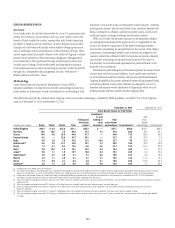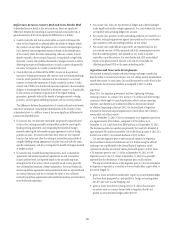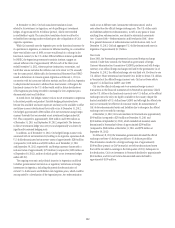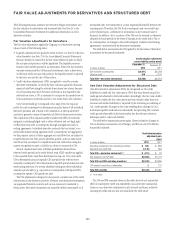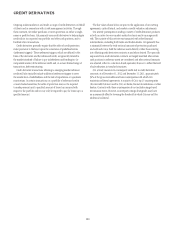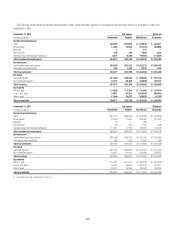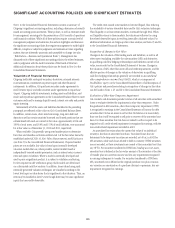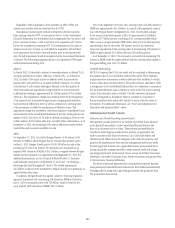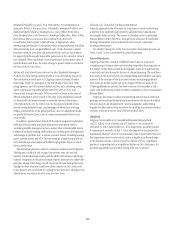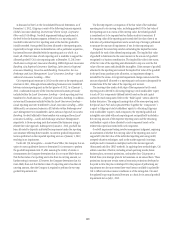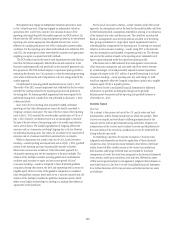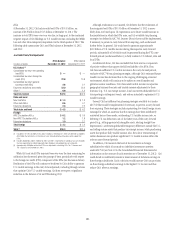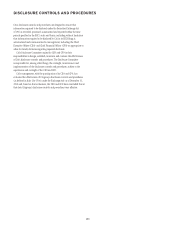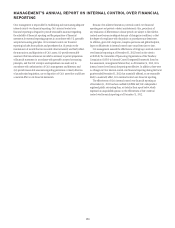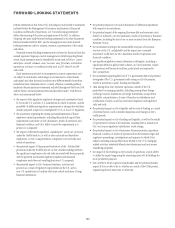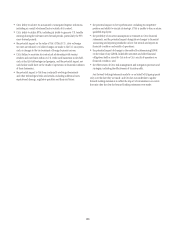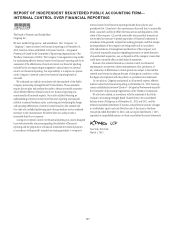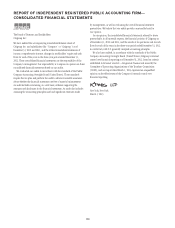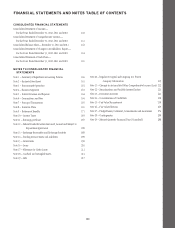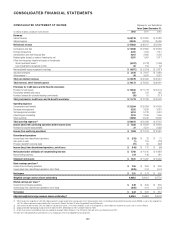Citibank 2012 Annual Report Download - page 152
Download and view the complete annual report
Please find page 152 of the 2012 Citibank annual report below. You can navigate through the pages in the report by either clicking on the pages listed below, or by using the keyword search tool below to find specific information within the annual report.130
Management may engage an independent valuation specialist to assist
in Citi’s valuation process. Citigroup engaged an independent valuation
specialist in 2011 and 2012 to assist in Citi’s valuation for most of the
reporting units employing both the market approach and DCF method. Citi
believes that the DCF method, using management projections for the selected
reporting units and an appropriate risk-adjusted discount rate, is most
reflective of a market participant’s view of fair values given current market
conditions. For the reporting units where both methods were utilized in 2011
and 2012, the resulting fair values were relatively consistent and appropriate
weighting was given to outputs from both methods.
The DCF method used at the time of each impairment test used discount
rates that Citi believes adequately reflected the risk and uncertainty in the
financial markets generally and specifically in the internally generated cash
flow projections. The DCF method employs a capital asset pricing model in
estimating the discount rate. Citi continues to value the remaining reporting
units where it believes the risk of impairment to be low, using primarily the
market approach.
Citi performed its annual goodwill impairment test as of July 1, 2012.
The results of the 2012 annual impairment test validated that the fair values
exceeded the carrying values for the reporting units that had goodwill at
the testing date. No interim goodwill impairment tests were required to be
performed during 2012, outside of the test performed as of January 1, 2012,
as discussed above.
Since none of Citi’s reporting units are publicly traded, individual
reporting unit fair value determinations cannot be directly correlated to
Citigroup’s common stock price. The sum of the fair values of the reporting
units at July 1, 2012 exceeded the overall market capitalization of Citi as of
July 1, 2012. However, Citi believes that it was not meaningful to reconcile
the sum of the fair values of its reporting units to its market capitalization
due to several factors. The market capitalization of Citigroup reflects the
execution risk in a transaction involving Citigroup due to its size. However,
the individual reporting units’ fair values are not subject to the same level of
execution risk or a business model that is perceived to be as complex.
While no impairment was noted in step one of Citi’s Local Consumer
Lending—Cards reporting unit impairment test as of July 1, 2012, goodwill
present in the reporting unit may be particularly sensitive to further
deterioration in economic conditions. Under the market approach for
valuing this reporting unit, the key assumption is the price multiple. The
selection of the multiple considers operating performance and financial
condition such as return on equity and net income growth of Local
Consumer Lending—Cards as compared to those of selected guideline
companies. Among other factors, the level and expected growth in return on
tangible equity relative to those of the guideline companies is considered.
Since the guideline company prices used are on a minority interest basis, the
selection of the multiple considers the guideline acquisition prices, which
reflect control rights and privileges in arriving at a multiple that reflects an
appropriate control premium.
For the Local Consumer Lending—Cards valuation under the income
approach, the assumptions used as the basis for the model include cash flows
for the forecasted period, assumptions embedded in arriving at an estimation
of the terminal year value and discount rate. The cash flows are estimated
based on management’s most recent projections available as of the testing
date, giving consideration to target equity capital requirements based on
selected guideline companies for the reporting unit. In arriving at a terminal
value for Local Consumer Lending—Cards, using 2015 as the terminal
year, the assumptions used included a long-term growth rate. The discount
rate used in the analysis is based on the reporting units’ estimated cost of
equity capital computed under the capital asset pricing model.
If the future were to differ adversely from management’s best estimate
of key economic assumptions and associated cash flows were to decrease
by a small margin, Citi could potentially experience future impairment
charges with respect to the $111 million of goodwill remaining in its Local
Consumer Lending—Cards reporting unit. Any such charge, by itself,
would not negatively affect the Company’s regulatory capital ratios, tangible
common equity (TCE) or liquidity position.
See Note 18 to the Consolidated Financial Statements for additional
information on goodwill, including the changes in the goodwill
balance period-over-period and the reporting unit goodwill balances as
of December 31, 2012.
Income Taxes
Overview
Citi is subject to the income tax laws of the U.S. and its states and local
municipalities, and the foreign jurisdictions in which Citi operates. These
tax laws are complex and are subject to differing interpretations by the
taxpayer and the relevant governmental taxing authorities. Disputes over
interpretations of the tax laws may be subject to review and adjudication by
the court systems of the various tax jurisdictions or may be settled with the
taxing authority upon audit.
In establishing a provision for income tax expense, Citi must make
judgments and interpretations about the application of these inherently
complex tax laws. Citi must also make estimates about when in the future
certain items will affect taxable income in the various tax jurisdictions,
both domestic and foreign. Deferred taxes are recorded for the future
consequences of events that have been recognized in the financial statements
or tax returns, based upon enacted tax laws and rates. Deferred tax assets
(DTAs) are recognized subject to management’s judgment that realization is
more-likely-than-not. See Note 10 to the Consolidated Financial Statements
for a further discussion of Citi’s tax provision and related income tax assets
and liabilities.


